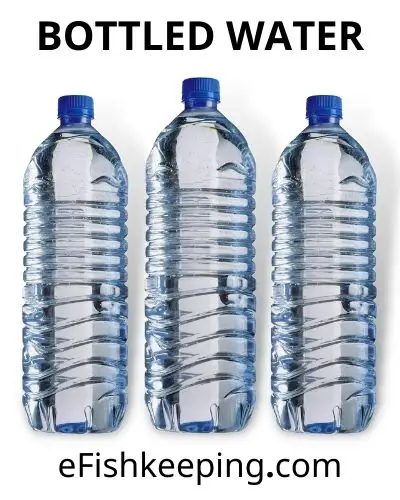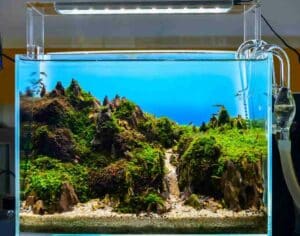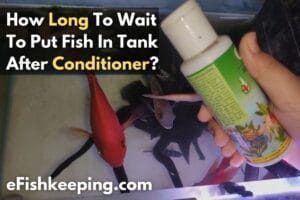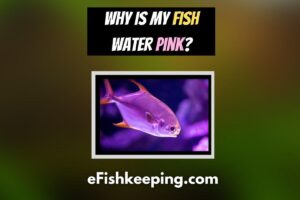Are you curious if you can use bottled water in a fish tank? Then you are exactly in the right place!
In this guide, I will give you a complete quick overview of bottled water, whether you can use it or not for your aquarium, and other related questions. So without further ado, let’s get started!
Bottled Water: A Quick Overview
Before we dive into the details of using bottled water, let’s first understand what bottled water actually is. So, the term bottled water refers to drinking water (e.g., well water, distilled water, mineral water, or spring water) packaged in plastic or glass bottles.
The below table lists some of the common types of bottled water:
| Alkaline Water | This water has increased level of pH and produced through electrolysis |
| Mineral Water | This water is from a mineral spring that has different minerals like sulfur and salt compounds. |
| Purified Water | This water is produced by distillation, deionization, reverse osmosis, or other suitable procedures. This water is also sometimes referred to as demineralized water. |
| Sparkling Water | This type of water contains the equal amount of carbon dioxide that it had when it originated from the source. Generally the carbon dioxide may be removed and then replenished after the treatment is done. |
| Spring Water | A popular form of bottled water that comes from an underground formation from which the water flows naturally to the Earth’s surface. |
| Well Water | The well water comes by hole tapping, etc. This hole can be either drilled, bored or constructed in the ground. |
So, bottled water can come from different sources. In some products, tap water is bottled while in others, fresh spring water or other sources are used.
Typically, water can have different dissolved minerals and mineral content is expressed as (TDS) Total Dissolved Solids in the water. (
Bottled water that is usually sold as mineral water, generally have a higher TDS content compared to the tap water (because the users expect the mineral salts in their mineral water)
On the other hand, the distilled or demineralized water is treated in a way to remove almost all the minerals that occur naturally in the water.
Note that the natural water remains unmodified by mineral addition or deletion. But the groundwater can contain minerals dissolved since the water passes through the soil and rocks.
Most often, natural bottled water or mineral water are the ones used to replace tap water.
Some bottled waters are also carbonated and they are referred to as sparkling water. This type of water has a “fizz” present that is generated because of the carbon dioxide gas.
On the contrary, water that doesn’t have any added carbonation is considered still water. And, the ordinary tap water and most bottled water that we find in large containers are examples of still water.
Can You Use Bottled Water In A Fish Tank?

It is generally ok to use bottled water for fish tanks, provided it is treated with a water conditioner and other procedures to make it safe for fish tank usage. Typically, bottled water can have less chlorine than tap water, but still, it is a good practice to treat it with a water conditioner.
Manufacturers of bottled water use either the reverse osmosis or distillation process to remove particles from the water source and so the bottled water typically has less chlorine than the tap water.
Depending on the type of bottled water, it may contain enough minerals and nutrients required by your aquarium fish to live. However, some bottled water may also contain excessive amounts of minerals and nutrients which is not so good.
It is essential to note that an excess intake of minerals either from a diet or gill uptake can lead to toxicity.
So overall, it is also crucial to check the pH level of the bottled water that you are going to use for your fish tank.
How To Make Bottled Water Safe For Fish Tanks? (Top 4 Tips!)
#1. Removing Chemicals Like Chlorine From Bottled Water
I mentioned that bottled water can come from a variety of sources. So while using bottled water try to check out what type of bottled water you are using. If simply tap water is stored in a bottle, then it might also have chemicals like chlorine.
Chlorine is added to tap water mainly for disinfection purposes, to kill the bacteria. Now although chlorine is relatively harmless to humans, it can be deadly for our fish.
At high concentration, chlorine is toxic to fish. But even at the lower concentrations, it is likely going to stress your fish by damaging their gills.
As a general rule, the amount of chlorine in tap water can be between 0.5 and 2.0 ppm. And did you know that chlorine can be lethal to most fish at the level between 0.1-0.3 ppm. Hence, it becomes vital to lower and neutralize the chlorine levels before using it for aquariums.
And how can that be done? Short answer: Aquarium Conditioners!
Aquarium conditioners can be of several types. For example, a dechlorinator is a type of water conditioner that only removes but leaves the ammonia and other heavy metals.
When you treat the water to detoxify, neutralize it and make it safe for your aquarium, it is good to use a complete conditioner.
A complete conditioner not only helps in eliminating chlorine but it also helps in neutralizing ammonia, detoxifying heavy metals, buffering pH and more.
#2. Remineralization of Bottled Water
Depending on the type of bottled water you use, you may also have to remineralize it. If it is just tap water filled in a bottle, then maybe just conditioning will do. Because it will still have all the necessary minerals required to maintain a proper habitable aquatic environment for your fish.
However, if the bottled water has gone through different filtration processes and has lost many minerals, then you will have to remineralize it.
For re-mineralizing purified water, you can use things like epsom salt, calcium chloride, and baking soda.
However, using a commercially available product for this re-mineralizing purpose might be more helpful and easy for you.
#3. Adjusting The Hardness Of The Water
On the other hand, if you find that your bottled water has more hardness than what is usually recommended for your fish, then you may also have to reduce the water hardness.
Out of the different ways to soften the aquarium water, one of the methods is to use peat moss as a filter media. When you use peat moss as a filter media, it reduces the hardness level in water by binding calcium and magnesium ions.
This procedure is also called chelation and it softens the fish tank water through demineralization.
Other than the peat moss filter method, you can also utilize the Reverse Osmosis method. Reverse Osmosis (RO) is a demineralization/deionization process used in our fishkeeping hobby to make the water pure.
In this process, water is pushed through a semipermeable membrane that captures almost 99% impurities. Since the membrane can also block large molecules, like minerals (calcium & magnesium), softening of water happens as a result.
However, do note that Reverse Osmosis Water will also have to be re mineralized before you can use it for your fish tank.
If you own a large tank, investing in a RO system can be a great investment. Because through reverse osmosis you get a highly pure water that is free of water hardness, toxins, chemicals like chlorine. It also helps in removing up to 99% of dissolved solids in water.
#4. Performing Water Tests
After removing the harmful chemicals and re mineralizing the bottled water, it’s the time for final check – to test the water!
Measure the quality of your water by conducting a water test. Purchase a water test kit to measure your fish tank’s water quality.
Will Bottled Water Kill Fish?
Generally, bottled water won’t kill your fish unless it has chemicals like chlorine present in it or if it lacks the necessary elements required to make the water habitable for the fish. Treating the bottled water with an aquarium water conditioner and remineralizing can make it safe for the fish.
Please note by bottled water, I’m only referring to whatever I previously in the bottled water overview section.
There are mainly two challenges of using bottled water:
- Whether chemicals like chlorine are present or not?
- Does the water lack or has excessive amounts of minerals and other elements?
Once we can deal with both the above problems, our bottled water becomes almost completely safe for aquatic life.
Will Distilled Water Kill Fish?
Distilled water will kill fish because it lacks minerals and the salts from the fish’s blood will diffuse out into the distilled water. Distilled water alone is a poor choice for aquariums, so you should avoid using it to fill your aquarium.
If you want to top off your tank with a pure distilled water then you can do so without any issue. (Because when water evaporates, the mineral doesn’t go with it and instead stays where it should.)
If you want to lower the hardness of your tap water, then also you can use distilled water. Distilled water usage is one of the best ways to reduce the hardness of tap water.
However, remember that, to make use of distilled water for your fish tank, you need to re-mineralize it before using.
Is Purified Drinking Water Safe For Fish Tanks?
The purified water is pure and free of contaminants and chemical pollutants, making it safe for your fish. But you must still need to treat the water to reach the correct pH levels before adding your fish to the water.
Purified drinking water is safe for fish tanks provided adequate remineralization is done and the water is made suitable for the aquatic life inside the tank.
Generally, purified water is filtered to remove chemicals like chlorine and other contaminants so you can use it for fish tanks.
However, it may also be free from trace elements that are important for osmoregulation and hardness which prevents pH swings. The process through which you can add those elements in the water is what we called remineralization.
Did You Know? Bottled water can cost about 1000 times more than tap water. As a general rule, in the case of most municipal water, the cost is 1 cent per gallon. On the other hand, a bottle of water can typically cost over $1 for 20 ounces.
So that is something you can keep in mind while using bottled water for your fish tank
Final Thoughts – What Is The Best Water To Use In A Fish Tank?
The best and the most convenient water to use in a fish tank is tap water along with an aquarium water conditioner. Although it can contain chemicals like chlorine and chloramine, they can be easily removed using an aquarium water conditioner.
Moreover, tap water is easily available, costs less compared to bottled water, and already has almost all the necessary components required to make a perfect aquatic environment for fish. Yes, you do need to add the water conditioner, but it’s a pretty easy task.
A bottled purified water may be free of harmful contaminants or chemicals because of the filtration process it undergoes. But again, you will have to remineralize it every time you use it for a fish tank which can become an additional task-load while doing the fish tank maintenance.
Of course, if you live in an area where the tap water is of very poor quality, then the next best option is to use bottled water or any type of filtered/purified water. However, do make sure to also remineralize, test, and treat the water accordingly to make it safe for your aquarium.
Finally, whatever water you use, as long as you can make it suitable for the aquatic life inside the tank, you are good to go with it.
Hope this has helped you to clarify your doubts and questions.
Please share this article with others if you like it. And you can also read my following articles:
Hi! I’m Praveen Ghoshal, the founder of eFishkeeping.com. Inspired by my Dad, I got interested in fishkeeping when I was a kid. Since then, I have been involved with this hobby. Currently, I have 3 fish tanks at our home, and I enjoy this hobby with my full family. Read more about me here.







![Too Much Oxygen In Fish Tank? [All You Need To Know!] can-you-have-too-much-oxygen-in-fish-tank](https://efishkeeping.com/wp-content/uploads/2022/06/Can-You-Have-Too-Much-Oxygen-In-Fish-Tank-Explained-300x200.jpg)